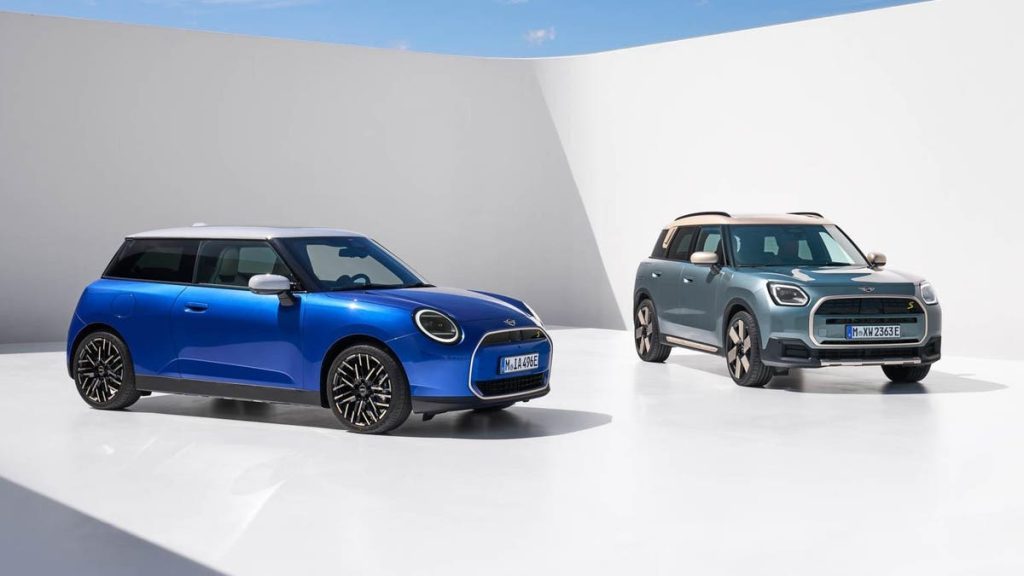The original electric Mini built a fond following, despite its distinct deficiencies in range. But with so many great new EVs arriving on the market all the time now, it was past time for an update. Thankfully, a new electric Mini has arrived – except like London buses, two have come at once. These have much improved range from brand new platforms, but will they be enough to bring back the brand’s former electric glory?
The new Minis include a refreshed Cooper three-door, and the brand-new Countryman five-door. The former is a considerable upgrade on its predecessor, albeit most noticeably in range. The Facelift Mini Electric offered up to 145 miles of WLTP range, but the new version provides at least 199 miles. That’s the basic E with a 40.7kWh battery (compared to the original car’s 32.6kWh). The SE version has a larger 54.2kWh battery, giving it a 250-mile WLTP range – nearly twice that of the previous car.
Although Mini says the new Cooper has an updated drivetrain, its performance starts at the same level as before, and it remains front-wheel-drive. The E still has 184hp and takes 7.3 seconds to reach 62mph. But the SE ups the ante with 218hp and the ability to sprint to 62mph in 6.7 seconds. However, while that seems quick by fossil fuel vehicle standards, there is an increasing number of EVs that surpass this figure considerably. There is a John Cooper Works (JCW) version of the Cooper Electric on the horizon, but it’s not expected until 2025.
The Countryman is a new electric member of the Mini family and comes with a significant update to the model in fossil fuel form as well. Both versions of the Countryman Electric sport a 64.7kWh battery. The E version allies this unit with a 204hp motor, enabling a sprint to 62mph in 8.6 seconds and 287 miles of range. The SE ALL4 version, as the name suggests, is all-wheel drive and boasts 313hp and 494Nm of torque, enabling it to hit 62mph in just 5.6 seconds. However, the additional power drops the range to 269 miles.
The new Cooper Electric doesn’t look so different to the previous version externally. There is less use of yellow to signal this is the EV model, with just the yellow S remaining. The air scoop on the bonnet / hood has gone. The car is meant to echo the past but still be thoroughly modern. The Countryman, however, has diverged even further from the round lights that have been a mini signature since birth, and is bigger than previous models as well. It is starting to look even more like the SUV / Crossover class that it inhabits.
The interior design has been significantly updated on both cars, however. One area of particular controversy is the removal of the instrument cluster in favor of only having an infotainment screen, like a Tesla Model 3 or Y. However, this is a massive 24in round OLED, allegedly the largest OLED display in the world at the moment. There are still plenty of physical controls, and if you want features such as speed and sat-nav instructions right in front of you, there’s a Head-Up Display option to provide this, although it uses a panel rather than projecting directly onto the windscreen. So Mini hasn’t gone quite so far as Tesla in removing all instrumentation display and discrete buttons.
The Cooper Electric is a significant update on the previous vehicle, with a much more usable range, particularly with the SE version. The Countryman goes even further in that direction, and strangely offers the highest acceleration yet in an electric Mini, at least until the JCW version of the Cooper arrives. This places the Mini Electric into a much more mainstream space than being a fun EV that you can probably only use for shorter urban journeys.
Pricing isn’t extortionate, either, although it does come in higher than the previous models. The Mini Cooper Electric E starts at £30,000 ($37,900), rising to £34,500 ($43,600) for the SE. The Countryman Electric E starts at £41,500 ($52,500), with the SE ALL4 priced at £46,600 ($58,900). You can be sure that upgraded trims and options will add to these base prices, though.
It’s also worth considering what else sits in this price bracket. Instead of the Cooper Electric, you could choose the keenly priced MG4. The MG4 XPOWER is only £2,000 ($2,500) more than the Cooper Electric SE, but shaves nearly 3 seconds off the 0-62mph spring, with only 11 fewer WLTP miles of range. It’s also a four-door vehicle with much more space. But the Cooper Electric SE will still be nippy and you might prefer its image.
The Countryman Electric competes with popular EVs such as the Hyundai Kona, Kia Niro EV and even the MG ZS EV Long Range, all of which undercut it considerably on price. The Hyundai and Kia beat it on range, but not performance. The Countryman will also counter with the style and BMW / Mini quality, with lots of design choices and special editions to choose from. The price doesn’t venture into the territory of larger SUVs such as the Tesla Model Y or BMW’s own iX1 or iX3. So in some respects it’s about right for the brand, if not exactly a bargain.
In other words, neither new Mini is likely to be the must-have car that cracks EV sales wide open into the mainstream (unlike the original Mini). But both take the Mini Electric back into contention and broaden appeal to families with the Countryman. The new Mini Cooper Electric will arrive on the UK market in May 2024, with the Countryman arriving a few months earlier in February. Considering how much fun the original Mini Electric was to chuck around windy roads, I can’t wait to give both new cars a try.
Read the full article here









